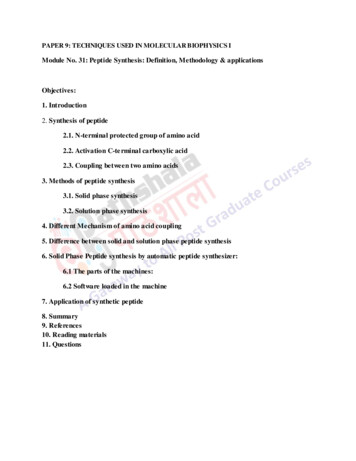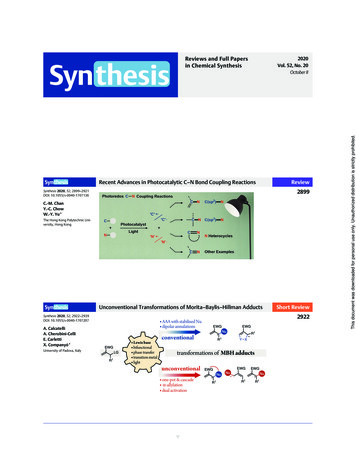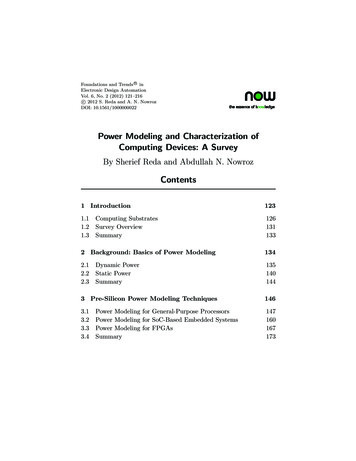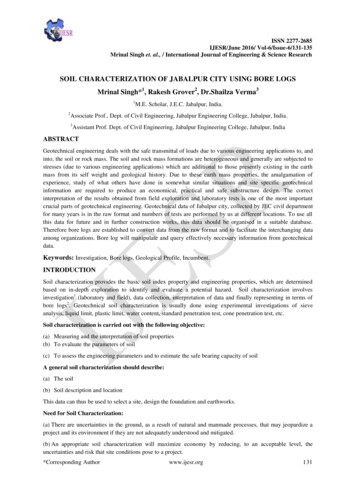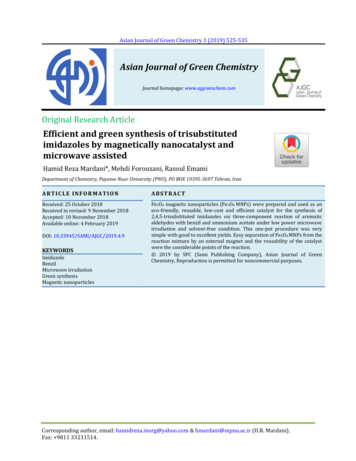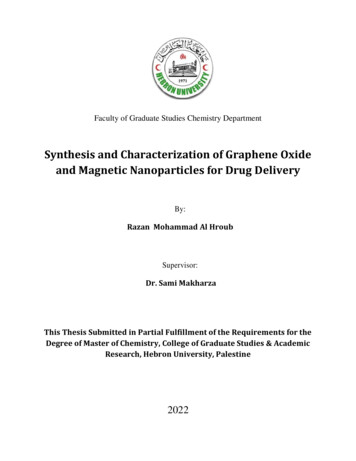
Transcription
Faculty of Graduate Studies Chemistry DepartmentSynthesis and Characterization of Graphene Oxideand Magnetic Nanoparticles for Drug DeliveryBy:Razan Mohammad Al HroubSupervisor:Dr. Sami MakharzaThis Thesis Submitted in Partial Fulfillment of the Requirements for theDegree of Master of Chemistry, College of Graduate Studies & AcademicResearch, Hebron University, Palestine2022
DedicationI dedicate this thesis to everyone who helped and make it possible, backed me up,whether it was with a phrase or a deed.To my family, my beloved husband, colleagues, and my supervisor Dr. Sami Makharza, havesent me a special gift.I'd like to thank the teaching staff at Hebron University chemistry department, as well as thetechnicians in the chemistry and pharmacy labs, who played a critical role in this project success.i
AcknowledgmentAt the outset of my thesis, I want to express my heartfelt gratitude to my wonderfulparents, and my husband’s family for their love and support, special thanks to my husbandEyad AL-Aqabna, without support and encouragement, I would not have been able to completemy studies to my satisfaction, and I do not forget to thank my daughters, Eman and Reman, fortheir love and support during my research.I’d like to express my heartfelt gratitude to my supervisor Dr. Sami Makharza, for his support,guidance, assistance, and helpful feedback.Finally, thank my colleague Majdoleen AL-Atawna for always being there for me during mydarkest hours, she always consoled me.ii
Table of contentsDedication . iAcknowledgment . iiTable of contents . iiiList of Tables . viList of Figures . viiList of Abbreviations . viiiAbstract . ixChapter One: Introduction .11.1Nanotechnology in Medicine . 21.2Carbon Nanomaterial . 31.2.1Fullerene . 41.2.2Carbon Nanotube ( CNT) . 51.2.3Graphene . 61.3Magnetism . 81.4Magnetic nanoparticles . 101.5Modification of nanoparticles . 121.6Nanotechnology in cancer therapy . 131.7Nanosystem for drug delivery. 151.8Research objectives . 16Chapter Two: Literature Review . 172.1Graphene oxide . 182.2Magnetite ( Fe3O4). 182.3Graphene oxide / chitosan / magnetite nanocomposites . 20Chapter Three: Methodology . 22iii
Materials and Methods . 233.13.1.1Chemicals . 233.1.2Instrumentation. 23Methods . 233.23.2.1Preparation of graphite oxide . 233.2.2Preparation of graphene oxide nanoparticles . 243.2.3Synthesis of iron oxide particles (Fe3O4) (co-precipitation) . 253.2.4Preparation of graphite oxide-Fe3O4 nanoparticles . 253.2.5Preparation of graphene oxide-Fe3O4 nanoparticles . 263.2.6Preparation of graphite oxide with chitosan . 263.2.7Preparation of graphene oxide with chitosan . 263.2.8Preparation of graphite oxide-chitosan-Fe3O4 nanoparticles . 263.2.9Preparation of graphene oxide-chitosan-Fe3O4 nanoparticles . 27Chapter Four:Result and Discussion . 28Characterization . 294.14.1.1Fourier-transform infrared spectroscopy (FT-IR) . 29I.FT-IR of Graphite, Graphite oxide-450nm, Graphene oxide-200nm . 29II.FT-IR of Fe3O4 . 30III. FT-IR of (GO-450 nm / Fe3O4) and (GO-200 nm / Fe3O4) . 31IV. FT-IR of chitosan . 32V.FT-IR of GO-450 nm /Cs and GO-200 nm /Cs . 33VI. FT-IR of GO-450 nm / Cs / Fe3O4 and GO-200nm / Cs / Fe3O4 . 354.1.2UV-visible spectrophotometer study . 36I.UV-visible spectroscopy of iron oxide particles . 36II.UV-visible of GO-450 nm and GO-200 nm. 37III. UV-visible of GO-450 nm / Fe3O4 and GO-200 nm / Fe3O4. 37iv
IV. UV-visible of chitosan . 39UV-visible of GO-450 nm / Cs and GO-200 nm / Cs. 40V.VI. UV-visible of GO-450 nm/Cs/Fe3O4 and GO-200 nm/Cs/Fe3O4 . 404.1.3Synthesis of Fe3O4 . 414.1.4Differential scanning calorimetry (DSC) . 42Chapter Five: Conclusion and Recommendations . 461.1Conclusion . 471.2Recommendations . 47References . 48v
List of TablesTable 1: Examples of nanoparticales used in biological research. 3Table 2: Physical properties of magnetite. . 11Table 3: Some examples of modified by different materials . 12vi
List of FigureFigure 1. Allotropes of carbon. . 4Figure 2. Single, double and multi walled carbon nanotubes. 5Figure 3. Types of single-walled carbon nanotubes. . 6Figure 4. Structure of graphene oxide (GO) . 7Figure 5. types of materials magnetism . 9Figure 6. Structure of chitosan. . 13Figure 7. Passive and active targeting of nanoparticles. . 15Figure 8. Preparation steps of graphite oxide . 24Figure 9. Magnetic nanopartical during preparation . 25Figure 10. FT-IR spectra of (a) graphite, (b) graphite oxide and (c) graphene oxide . . 30Figure 11. FT-IR spectrum of Fe3O4. . 31Figure 12. FT-IR of spectra of (a) GO-450 nm/Fe3O4, (b) GO-200 nm/Fe3O4. . 32Figure 13. FT-IR spectra of chitosan. . 33Figure 14. FT-IR spectra of (a)GO-450 nm /Cs and (b) GO-200 nm / Cs . . 34Figure 15. spectra of (a) GO-450 nm/Cs/Fe3O4 and (b) GO-200 nm/Cs/Fe3O4. . 35Figure 16. FT-IR spectra of Fe3O4 , GO-200 nm /Ch and GO-200 nm/Ch/Fe3O4 . . 35Figure 17. UV-Vis spectrum of Fe3O4 . . 36Figure 18. UV-Vis spectra of GO-450 nm and GO-200 nm. . 37Figure 19. UV-Vis spectra of GO-450 nm / Fe3O4 and GO-200 nm / Fe3O4. . 38Figure 20. The separation and redispersion of a solution of GO-200 nm / Fe3O4 in the absence (left) andpresence of an external magnetic field (right) . . 38Figure 21. UV-Vis spectrum of chitosan. . 39Figure 22. UV-Vis spectra of GO- 450 nm / Cs and GO-200 nm / Cs . . 40Figure 23. UV-Vis spectra of GO-450 nm/Cs/Fe3O4 and GO-200 nm/Cs/Fe3O4. . 41Figure 24. Magnetic activity of Fe3O4 particles with (a) and without external magnetic field (b). . 42Figure 25. DSC thermal study of Fe3O4. . 43Figure 26. DSC thermal study of GO-200 nm . . 44Figure 27. DSC thermal study of GO-200 nm / Fe3O4 . . 45vii
List of AbbreviationsFe3O4Iron(III) oxideRPMRotation per minuteDMFN,N-Dimethylformamide (C3H7NO)Øpour size of filter paperFT-IRFourier-transform infrared spectroscopyMNPsMagnetic nanoparticalsUV-VisUltraviolet – visible absorption spectroscopyGO- 450 nmGraphite oxide-450 nmGO- 200 nmGraphene oxide-200 nmDSCDifferential Scanning CalorimetryCsChitosanCNTsCarbon nanotubesSWCNTsSingle-walled carbon nanotubesDWCNTsDouble-walled carbon nanotubesMWCNTsMulti-walled carbon nanotubesD.WDistilled waterviii
AbstractIn this thesis we have prepared and characterize two sizes of GO (450 and 200 nm). Aswell as, magnetic based iron oxide particles have been prepared and loaded on GO andfunctionalized GO based on chitosan molecules.The oxidation-reduction process was used to make graphite oxide (Hummers method), and theend product was designated graphite oxide as prepare (GO- 450 nm), Under controlledconditions, a tip sonicator was used to decrease the particle size to 200 nm (time and power ofsonication). A simple chemical reaction (Co-precipitation) between 𝐹𝑒 3 and 𝐹𝑒 2 producesmagnetic iron oxide particles called Fe3O4.FT-IR spectroscopy reveals that two sizes of GO particles (GO-450 nm and GO-200 nm) havedifferent types of oxygen groups on their surfaces, and the FT-IR spectrum of prepared Fe3O4 areshown a strong peak at around 588 cm-1 proving that the formation of magnetic particles isperformed. FT-IR spectra of (GO-200 nm/Cs/Fe3O4) exhibit sharp peak than (GO-450nm/Cs/Fe3O4). DSC ofFe3O4, GO-200 nmand GO-200 nm/Fe3O4 for identification thestructure. The UV- visible spectroscopy for two system{ (GO-450 nm/Cs/Fe3O4), (GO-200nm/Cs/Fe3O4 )} revealed the bandwidth increase with decreasing the size of nanoparticles.ix
Chapter One:Introduction1
1.1Nanotechnology in MedicineNanotechnology is a large and multidisciplinary field of study and development that hasgrown significantly in recent decades. Purposefully influencing matter at the nanoscale is a newidea, first proposed by Richard Feynman in a presentation to the American Physical Society in1959 titled "There is plenty of room at the bottom: an invitation to enter a new field ofphysics."[1]. In 1974, the term ‘nanotechnology’ was first given by a Japanese scientist, ProfNorio Taniguchi (University of Tokyo). Nanotechnology is the study and control of materialswith dimensions ranging from 1 to 100 nanometers, allowing for unique size-dependentcharacteristics[2]. The word "nano" comes from the Greek word "dwarf". Hence, a nanometer(nm) is one billionth of a meter.Nanomaterials are believed to be significantly more reactive than bulk materials because theyhave a large surface area and a high fraction of atoms at the surface. As a result, the physical andchemical characteristics of these nanostructure materials differ significantly from those of asingle atom (molecule) and bulk material of similar chemical structure. These nanostructures areincredibly tiny once produced, and they produce some unique and intriguing electrical, optical,structural, and electromagnetic characteristics in nanomaterials. Nanomaterials have attracted alot of interest and are being used for a variety of applications in textiles, drug delivery, energystorage systems, cosmetics, microelectronics, and healthcare due to their unique andadvantageous physical, chemical, and mechanical characteristics[3].In nanomedicine, which is the use of nanotechnology in medicine, nano-scaled materials andnano electronic biosensors are used to diagnose, monitor, follow-up, and prevent illnesses. Manydiseases today, ranging from diabetes to cancer to Parkinson's and Alzheimer's, pose a seriousdanger to human life, and precise diagnosis is critical for proper treatment. Nanosensors andnanoparticles made using nanotechnology are critical for accurate diagnosis and rapidtreatment[4].Ultrasensitive and selective multiplexed diagnostics, drug delivery, targeted treatment of cancerand other illnesses, body imaging, tissue/organ regeneration, and gene therapy are the mostpotential future nanoscience-based uses in medicine. All of these applications combine technicaladvancements with better biological system manipulation methods[5]. Table1 shows somenanoparticles used in biological research.2
Table 1: Examples of nanoparticales used in biological researchNanoparticleApplicationReferenceMagnetic nanoparticlesSpecific targeting of cancer cells, tissueimaging[6]Silicon-based nanowiresReal-time detection and titration ofantibodies,virus detection, chip-based biosensors[7],[8]Carbon nanotubesElectronic biosensors[9]polymer–drug nanoparticlesColorectal cancer, lung metastasistreatment[10]graphene oxide nanoparticlefunctionalized withpolyethylene glycol and folic acidanticancer drug delivery[11]silver nanoparticlestreatment of lungcancer[12]Fluorescent nanodiamondrepair of lung stem cells[13]1.2 Carbon NanomaterialCarbon is an element with atomic number 6. The periodic table of the elements places itin group IV. The ability of some chemical elements to form a variety of molecular shapes fromthe same kind of atoms is known as "allotropy". Graphite, diamond are carbon allotropes[14].The carbon atoms in graphite are sp2 hybridized, meaning that each carbon has three covalentbonds (σ bonds) with three other carbons in the same plane. The fourth valence electron that isnot involved in the sp2 hybridization is delocalized through π-π interaction, resulting in in-planemetallic bonding. As a result, the bonding inside the layer is a combination of covalent andmetallic bonding. The neighboring layers, on the other hand, are weakly bonded by van derWaals forces, but the carbon atoms in diamond have been sp3 hybridized, which means that eachcarbon atom has four covalent bonds (σ bonds) that are directed tetrahedrally to four othercarbon atoms. There are no free electrons since all of the valence electrons are involved incovalent bonds. Diamond, as a result, is an electrical insulator[15].3
Meanwhile, various new allotropic forms have been described, including carbon nanomaterials,the most popular method for classifying carbon-based nanomaterials is to look at theirgeometrical structure. Carbon nanostructures can be tube-shaped, horn-shaped, spherical, orellipsoidal in form. Carbon nanotubes are tube-shaped particles; nanohorns are horn-shapedparticles; fullerenes are spheres or ellipsoids; and graphene is a single layer (monolayer) ofcarbon atoms (figure 1) [16].Figure 1. Allotropes of carbon.1.2.1 FullereneIn 1985 the fullerene was discovered by H.W. Kroto, R.F. Curl and R.E. Smalley [17],Fullerene is the C60 molecule, which is made up entirely of carbon atoms and contains no otherelements. The molecule has the shape of a ball, with diameter about 0.7 nm [18]. Each carbonatom is connected to three other carbon atoms by three bonds, and it is frequently found near thevertices of pentagons and hexagons on the sphere's surface. The word fullerene was coined inhonor of Buckminster Fuller, an American architect who created a huge geodesic dome that4
mirrored the molecular structure of C60. Bucky balls are the name for these balls, other possiblefullerene structures are C20, C24, C28, C32, C36, and C60. Fullerenes are employed as catalysts,lubricants, and carriers for delivering drugs into the body [15].1.2.2 Carbon Nanotube ( CNT)CNTs are a type of carbon allotrope with unique characteristics that make them ideal fortechnological applications, S. Iijima, a Japanese researcher, discovered CNTs in 1991[19].Carbon nanotubes are cylindrical structures made up of rolled graphene sheets with a diameter ofseveral nanometers. The length, diameter, chirality (symmetry of the rolled graphite sheet), andnumber of layers of carbon nanotubes can all vary. CNTs are divided into three types based ontheir structure: single-walled carbon nanotubes (SWCNTs), multi-walled carbon nanotubes(MWCNTs) figure 2 [20], and double-walled carbon nanotubes (DWCNTs) [21].SWCNTs are made up of a single cylindrical carbon layer with a few micrometers in length anddiameter ranging from 0.4 to 2 nanometers, depending on the temperature at which they weremade. It was discovered that the bigger the diameter of CNTs is, the higher the growingtemperature. MWCNTs are made up of several coaxial cylinders. MWCNTs have an outsidediameter of 2 to 100 nanometers, an inside diameter of 1-3 nanometers, and a length of one toseveral micrometers [22].Figure 2. Single, double and multi walled carbon nanotubes.5
When compared to other fibrous materials, CNTs have a unique mix of rigidity, strength, andelasticity due to their structure. In comparison to other conductive materials, CNTs have a highthermal and electrical conductivity [23]. The chirality or hexagon orientation of SWCNTs withrespect to the tube axis determines their electrical characteristics. SWCNTs are divided into threesub-classes based on their electrical conductivity: (i) armchair (electrical conductivity copper),(ii) zigzag (semi-conductive characteristics), and (iii) chiral (semi-conductive characteristics) asexhibited in figure 3 [16].Figure 3. Types of single-walled carbon nanotubes.CNTs' functionalization allows them to be used in a variety of applications. Because of theirconstruction, the tubes contain an inner and outer core, both of which may be changed bydifferent functional groups. As a result, CNTs may be tailored to specific applications. The usesof carbon nanotubes in biomedicine are being studied in four primary areas: drug delivery,biomedical imaging, biosensors, and tissue engineering scaffolds [24].1.2.3 GrapheneGraphene is a two-dimensional allotropic carbon material made up of single carbon atomlayers as shown in figure 1. Carbon atoms in graphene show sp2-hybridization in a two-6
dimensional hexagonal crystal lattice linked by σ and π bonds. Other carbon allotropes, such asgraphite, carbon nanotubes, and fullerenes, contain graphene as a structural constituent.Theoretical graphene research began long before actual material samples were obtained. P. R.Wallace, a Canadian theoretical physicist, was the first to investigate the theory of graphene in1947, while A. Geim (a Dutch-British physicist) and K. Novoselov (a Russian-British physicist)described the first graphene samples 57 years later (in 2004), and were awarded the Nobel Prizein 2010 [25].High conductivity, huge surface area, and mechanical and thermal durability are only a few ofthe amazing features of graphene. These characteristics make graphene a useful material in avariety of applications, including fuel cell catalysis, supercapacitors, photocatalysis,heterogeneous catalysis, water purification, drug delivery, and biosensing [26]. Graphene is ahighly hydrophobic material that does not dissolve in hydrophilic solvents and collects into hugeaggregates. Graphene oxide (GO) (figure 4 [27]) is a frequently applied option to solve thisproblem.Chemical exfoliation of graphite powder with a strong oxidizing reagent yields extremelycolloidally stable exfoliated hydrophilic GO sheets. Carbons with sp 2 (C C, C O) and sp3 (C–C, C–OH, C–O–C) hybridization, as well as oxygen functionality such as hydroxyl, epoxy,carbonyl, and carboxyl groups, are found in GO [28].Figure 4. Structure of graphene oxide (GO)7
1.3MagnetismThe alignment of the electron spin causes magnetism or magnetic effects in a substance.The spin of electric-charged particles (electrons, holes, protons, positive and negative ions) withboth mass and electric charges can result in the formation of a magnetic dipole, or magneton.Thus, materials' magnetism may be divided into five fundamental kinds, namelyparamagnetism, diamagnetism, ferromagnetism, ferrimagnetisms, and antiferromagnetismas shown in figure 5 [29], based on their reactions to an external magnetic field and theorientation of magnetic moments in materials [30].Very weak; exists only in presence of an external field, non-permanent, becoause the appliedexternal field acts on atoms of a material, slightly unbalancing their orbiting electrons, andcreates small magnetic dipoles within atoms which that oppose the applied field. This actionproduces a negative magnetic effect known as diamagnetism, such as Cu, Ag, Si, Ag andalumina are diamagnetic at room temperature [31].Slightly stronger; dipoles line up with the field when an external field is introduced, resulting inpositive magnetization. Para-magnetic materials are those that have a modest positive magneticsusceptibility in the presence of a magnetic field. The orientations of atomic magnetic momentsare random in the absence of an external field, resulting in no net magnetization; nevertheless,when an external field is introduced, dipoles line up with the field, resulting in positivemagnetization. Furthermore, if the magnetic field is removed, the effect is gone. Many materials,such as aluminum, calcium, titanium, and copper alloys, cause paramagnetism [32].Because magnetization occurs only in the presence of an external field, both dia- and paramagnetic materials are classified as non-magnetic. However, even in the absence of an externalfield, certain materials have permanent magnetic moments. This is due to unfilled energy levelsforming permanent unpaired dipoles. Due to the exchange interaction or mutual reinforcement ofthe dipoles, these dipoles can easily line up with the imposed magnetic field. These areferromagnetic chrematistics. Ferromagnetism materials (examples: Fe, Co, Ni, Gd) Ferromagnets are extremely powerful; when an external field is applied, the dipoles line sms.8thisclass:Anti-ferromagnetism,and
The dipoles line up in antiferromagnets, but in opposite directions, resulting in zeromagnetization. Example: Mn, Cr, MnO, NiO, CoO, MnCl. The inter-atomic spacing and atomiclocations are highly important in the exchange interaction, which is responsible for the parallelalignment of spins. The anti-parallel alignment of spins is caused by this sensitivity. There is nonet spin moment when the intensity of anti-parallel spin magnetic moments is equal, and theconsequent susceptibilities are extremely tiny.Net magnetization may be seen in some ceramic materials. Fe3O4, NiFe2O4, (Mn.Mg)Fe2O4,PbFe12O19, and Ba Fe12O19 are some examples. The dipoles of one cation may line up with thefield in a magnetic field, whereas the dipoles of another cation may not. Ferrites are the ceramicsinvolved, and the phenomenon is known as ferri-magnetism. The spins of various atoms or ionsline up anti-parallel in ferri-magnetism, similar to anti-ferro-magnetism. The spins, however, donot cancel each other out, and there is a net spin moment. These materials, like ferro-magnets,have a large yet field-dependent magnetic susceptibility because these ceramics are excellentinsulators, electrical losses are low, and ferrites may be found in a variety of devices, includinghigh-frequency transformers [30].Figure 5. types of materials magnetism9
1.4Magnetic nanoparticlesMagnetic nanoparticles abound in nature and can be discovered in a variety of biologicalstructures, where used in information storage and retrieval systems, new permanent magnets,magnetic cooling systems, magnetic sensors, biomedicine, and catalysis, as well as contrastagents for magnetic resonance imaging and cancer therapy agents [33].Iron oxide nanoparticles are the most often used magnetic nanoparticles, while may be found innature in a variety of structures and phases, including oxides, oxyhydroxides, and hydroxides. Atambient pressure, six phases of iron oxides can occur, including magnetite Fe 3O4, wustite FeO,and Fe2O3 (α-Fe2O3, γ-Fe2O3, β-Fe2O3, and ε-Fe2O3). Fe3O4 (magnetite), α-Fe2O3 (hematite), γFe2O3 (maghemite), and FeO (wustite) are the most frequent ferrous and ferric oxides that areresearched because of their unique properties at the nanoscale. Furthermore, these iron oxideshave strong magnetic properties in nature, surface enhancement and functionalization of thesemagnetic oxides at nanometric dimensions has a lot of applications, including biomedical,catalysts, batteries, magnetic resonance imaging agents (MRI), and biosensing [34].Black iron oxide, magnetic iron ore, loadstone, ferrous ferrite, and Hercules stone are all namesfor magnetite (Fe3O4), and it has the highest magnetic properties of any transition metal oxide.Close-packed planes of oxygen anions with iron cations in octahedral or tetrahedral interstitialsites characterize the magnetite crystal structure [35]. The oxygen ions in magnetite are arrangedin a cubic close-packed configuration. With Fe(III) ions distributed randomly between octahedraland tetrahedral sites, and Fe(II) ions in octahedral sites, magnetite exhibits an inverse spinelstructure [36].The active electrons in the 3d orbitals give magnetite its unique electronic and ferromagneticcharacteristics (unpaired electron spins), wherefore; in room temperature, magnetite is aferromagnetic substance, and It is a naturally occurring mineral that has the highest magnetic ofany transition metal oxide. The following table summarizes some of the physical
polymer-drug nanoparticles Colorectal cancer, lung metastasis treatment [10] graphene oxide nanoparticle functionalized with polyethylene glycol and folic acid anticancer drug delivery [11] silver nanoparticles treatment of lung cancer [12] Fluorescent nanodiamond repair of lung stem cells [13] 1.2 Carbon Nanomaterial

